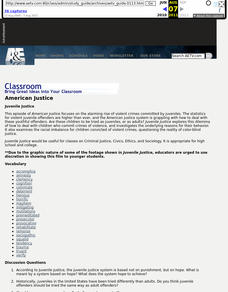American Documentary
Religion in Culture & Politics: Women’s empowerment in Syria
What defines a woman as empowered, and how does this definition compare to the ideas and actions of a group of Muslim women in Syria? After watching a series of video clips from a documentary film about a school for girls in Damascus,...
PBS
“He Named Me Malala”: Understanding Student Activism Through Film
Malala Yousafzai has become the face of social activism. After watching He Named Me Malala and short student-made films about what young people can do to become instruments of change, class members reflect on what it means to be an...
NPR
Women in Early Film Lesson Plan
The role of women in the early film industry, both on screen and behind the scenes, is the focus of a resource that asks class members to analyze movie posters and DVD covers from the 1910s and 1920s. Using examples drawn from the...
National Woman's History Museum
Defying Expectations: Unsung Hero: Marsha P. Johnson and the Stonewall Riots
The 1960s were a turbulent time, but the charismatic figure of Marshal P. Johnson is often left out of the provocative stories of the era. With primary sources that talk about Johnson and her role in the Stonewall Riots, scholars unpack...
Curated OER
Mathematics in Various Carees
Learners consider gender equity in mathematics careers. Students will view 12 15 minute episodes on future math careers then discuss that particular career as well as how women have been treated in both traditional and non traditional...
Curated OER
OBSERVING THE ROLES OF MALES AND FEMALES IN THE NURTURING OF THE YOUNG THROUGHOUT THE ANIMAL KINGDOM
Students watch animal videos to identify and compare the male/female roles of different species of animals. They draw conclusions and compare those roles to those of humans. They discuss how the human male/female roles have changed...
Childnet International
Crossing the Line: Cyberbullying
Members of the LGBTQ community are more likely to be bullied online than their peers—and bystanders who do nothing can be as problematic as the bullies themselves. Middle schoolers explore ways to protect themselves and others on the...
Curated OER
Casting Doubt: "Color-blind" and Nontraditional Casting Decisions
In his article about color-blind casting entitled, "Willy Loman Is Lost, Still Looking for Stimulus Plan and Some Dignity," Charles Isherwood quotes August Wilson as saying, "To mount an all-black production of a 'Death of a Salesman'...
Curated OER
History of Miss America
Students make a time-lines of of decades using images from Miss America. In this history lesson, students looks at the country's beauty pageant and how it changes the lives of women in America. Students debate issues such as size...
Curated OER
Gandhi's Alternate View of Women: Changing the Face of Modern Media & Advertising
Eleventh graders analyze the violence of media and advertising on women, as well as Gandhi's views of women. For this women and media lesson, 11th graders Killing Us Softly and Tough Guise as an analysis of media and advertising and...
Curated OER
Patriots v. Loyalists
Students consider how colonial citizens chose sides in the American Revolution. In this Revolutionary War lesson, students role play Loyalists, Patriots, and undecideds in a classroom simulation. Students research their positions so that...
Curated OER
American Justice: Juvenile Justice
Students watch a video that focuses on the alarming rise of violent crimes committed by juveniles. They see how the American justice system dealsl with these youthful offenders. They examine racial imbalance and color-blind justice.













